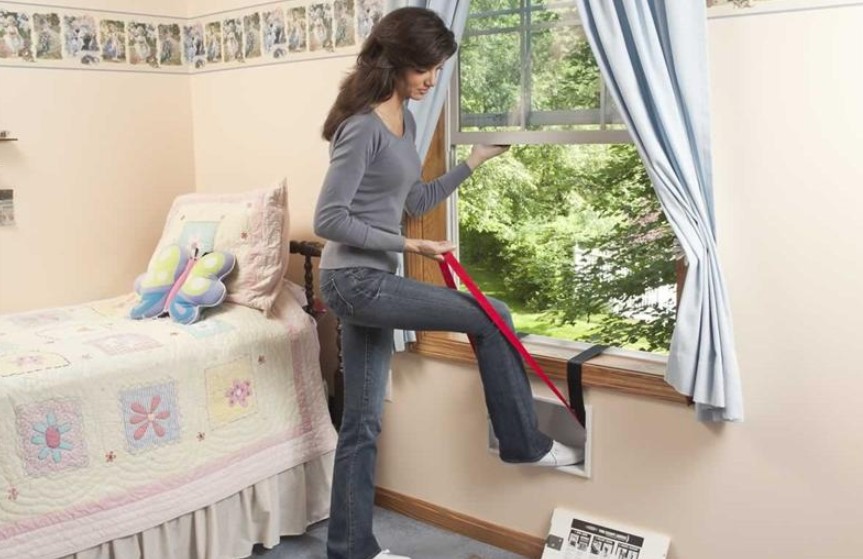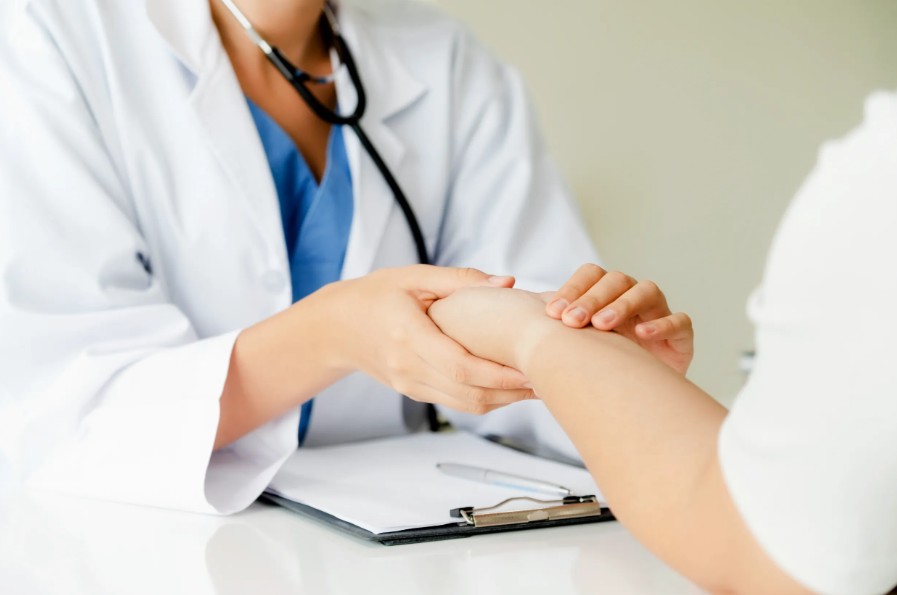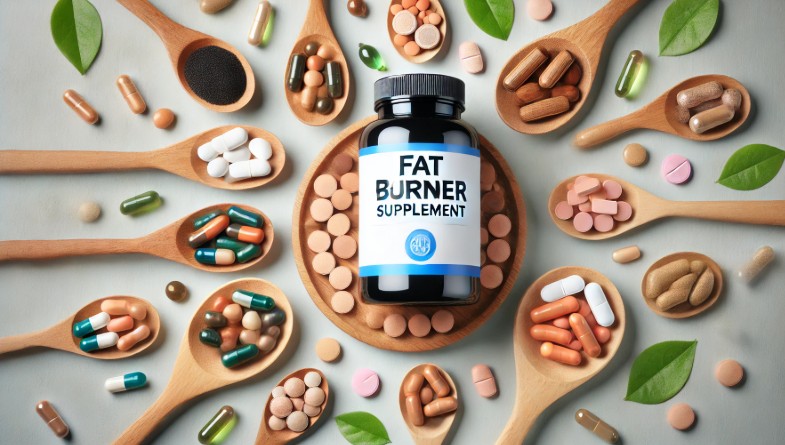
The most effective approach to losing weight is to include dietary changes and regular physical activity. But is it possible to lose weight without exercising?
For some people, physical activity just isn’t an option when trying to lose weight. There may be several reasons why you have to try losing weight without exercising:

Getty Images
Exercise and Weight Loss
Exercise helps the body burn calories more efficiently, says Dr. Scott A. Cunneen, director of metabolic and bariatric surgery at Cedars-Sinai Medical Center in Los Angeles and author of “Weighty Issues: Getting the Skinny on Weight Loss Surgery.”
This is because your metabolism elevates during physical activity. Over time, if exercise results in increased levels of lean body mass and less fat mass, your baseline metabolic rate (the amount of calorie your body burns when sitting still) should increase, as well, says Tamara Duker Freuman, a registered dietitian with New York Gastroenterology Associates. Without exercise, your metabolism will likely remain the same.
A speedier metabolism is one reason exercise is a natural companion to eating differently for weight loss. Depending on how much you exercise, it can help you lose weight more quickly. By watching what you eat, taking in fewer calories and burning off calories with exercise, you can create a greater energy deficit, helping to expedite weight loss, Duker Freuman explains.
Weight Loss Without Exercise
If you can’t exercise, it may take you longer to lose weight. This isn’t necessarily a bad thing because losing weight slowly can help you keep it off more easily than quick weight loss, says registered dietitian Jill Weisenberger, a registered dietitian, author of “Prediabetes: A Complete Guide” and “Diabetes Weight Loss – Week by Week” and owner of Food & Nutrition Solutions by Jill, based in Yorktown, Virginia.
Think Long-Term for Weight Loss
Weisenberger encourages those interested in losing weight without exercise to think about their long-term goals. One approach is to focus on weekly weight goals versus daily check-ins. A healthy weight loss is half a pound to 2 pounds a week, according to the Centers for Disease Control and Prevention.
For instance, you can set a goal of losing 10{35112b74ca1a6bc4decb6697edde3f9edcc1b44915f2ccb9995df8df6b4364bc} of your body weight in three to six months. If you weigh 200 pounds, that’s 20 pounds to lose.
“Oftentimes we overestimate the impact exercise has on calorie expenditure, but the most impactful thing you can do for weight loss is focus on creating health dietary patterns, drinking your water, managing your stress and sleeping well,” says Ashley Bannister, a registered dietitian and coach with the weight loss app Noom in New York City.
Losing weight without exercise is attainable, but it means you must focus more on cutting the calories you consume, while still making sure you eat nourishing food. Research indicates changes in diet as the primary method of successful and sustainable weight loss.
“The best strategy to do this is to increase your intake of fiber-rich foods that make you feel satisfied for longer even with modest amounts of calories; doing so helps ‘crowd out’ portions of more energy dense foods, especially lower fiber or higher sugar ones that don’t keep you feeling full for very long,” Duker Freuman says.
Examples of foods that promote satiety and are foundational to a diet that promotes a healthy weight include:
- Fruits and vegetables.
- Whole grains, such as whole-wheat spaghetti or whole-wheat bread.
- Protein, such as beans, fish, poultry and low fat dairy like Greek yogurt.
- A small amount of heart healthy fats, such as nuts, canola or olive oil.
Foods and drinks to cut out or consume less of if you’re looking to lose weight include:
- Alcohol-based and sweetened drinks, including juices and some coffees.
- Baked goods, such as cookies and cake.
- Candy.
- Snacks, such as chips, pretzels and crackers.
- Fried foods, such as french fries and onion rings.
- Low-fiber or refined carbohydrates, such as white bread, tortillas, white rice and grits.
Tips to Lose Weight Without Exercise
Losing weight without exercise is possible, it just takes extra planning and dedication. Here are 17 tips to lose weight without exercise:
Even when you can exercise, losing weight in a limited time period, such as in the weeks before a surgery, can be a challenge. Since you can’t move as much, it’s important to realize it may take longer and you may have some setbacks.
Another plate idea: If you’re at a holiday or special event with some of your favorite desserts, don’t deprive yourself, advises registered dietitian Heidi Katte, an instructor with Milwaukee Area Technical College in Milwaukee. Instead, serve yourself a portion using a small plate instead of a large plate.
At many restaurants, you have the option of a salad or soup before your main entrée, says Leslie Bonci, sports dietitian for the Kansas City Chiefs and owner of the nutrition business Active Eating Advice. If you choose a healthier soup or salad, you can fill up on fiber before moving on to your entrée. If you’re already somewhat full, you’ll eat less of the main meal and perhaps even skip dessert.
In the U.S., especially at restaurants, we’re accustomed to getting super-sized meals, Weisenberger says. Plan to eat only half of what you’re served. And don’t be afraid to take home leftovers.
- One medium whole fruit.
- 2 cups of salad greens.
- A ½-cup of cooked rice, pasta or cereal.
- 2 cups of milk.
- 1 ounce of cheese.
- 1 ounce of cooked seafood or meat.
This doesn’t mean you shouldn’t ever eat portion sizes bigger than these or that you have to measure everything you eat, according to the AHA. You may end up eating more than one serving at one meal and then eat less than one serving at another meal. Just aim for average portion sizes overall in any two- or three-day period.
We’ve all been there: You’re ready for a snack and open up the pantry. You see chips, cookies and other less nutritious options. It’s only natural to want to reach out and make those unhealthy choices. To help avoid this trap, stock your pantry with healthier snack options that will keep you feeling full longer, helping support your weight loss efforts.
Snacks that combine protein, healthy fat and/or complex carbs can achieve these goals. Some healthy snack options include foods such as:
- Greek yogurt with fruit.
- An apple or banana with a nut butter, such as peanut or almond butter.
- Cottage cheese with fruit on a piece of whole-grain bread.
- Hummus with whole-grain crackers and sliced veggies.
- A handful of nuts and a piece of fruit.
Think about the last few meals and snacks you ate. Were you reading or watching something on a screen? Maybe driving and eating? It’s easy to eat too much if you’re not focused on what you’re eating. Put away the phone, turn off the TV or remove whatever else distracts you to enjoy each bite.
Eating mindfully by chewing slowly is another way to focus on what you’re eating, so you’re truly aware of when you’re full, Katte says. Eating without distractions also can make you aware of whether you’re eating because you’re truly hungry or if you’re just bored.
Chewing your food helps with weight loss goals for several reasons, Bannister says:
- You slow down your meal and may be more mindful of your body’s hunger and fullness cues.
- You may burn slightly more calories through digestion when you chew thoroughly.
- Taking your time to chew thoroughly can positively affect the hormones related to hunger and feeling full so you ultimately consume fewer calories.
Fiber helps to fill you up so you stay full longer, meaning you’re eating less overall. The recommended serving for fiber is 25 grams a day for women and up to 38 grams a day for men, but most Americans struggle to get even 10 grams daily, Katte says.
Foods that are rich in fiber include:
- Beans. For example, 1 cup of black beans has 15 grams of fiber.
- Broccoli. 1 cup contains 5 grams of fiber.
- Pears. A medium pear has 5½ grams of fiber.
- Raspberries. 1 cup has 8 grams.
- Whole-wheat spaghetti or bread. 1 cup of whole-wheat spaghetti gives you 6 grams of fiber.
- Nuts, which are high in protein.
Most fruits and vegetables are rich in fiber. Make sure to increase your water intake as you add more fiber to your diet. Otherwise, it’s hard for the body to absorb the extra fiber, and you may end up feeling bloated or have extra intestinal gas.
Eating more fiber-rich foods while drinking more water is a winning weight-loss combination, Weisenberger says. Water helps to fill you up more, just like fiber does.
Here are a few ways to increase your water intake:
- Carry a water bottle with you.
- Set a water drinking schedule, so you make sure to drink water regularly during the day.
- If you’re working, make it a point to get up regularly and refill your water. This could mean going to the water fountain or the kitchen more regularly, Katte says. In either case, you’re getting more water and sneaking in a few extra steps.
Most sweetened drinks add empty calories and no nutritional benefit. Because they’re liquid, it’s easy to consume them quickly and then not feel full after. Sugary drinks like soda are often filled with calories and also can lead to a rise in blood sugar followed by a crash. The end result? You then feel hungry again, Bannister says.
- Water infused with fruits, like lemon or cucumber, or just a splash of 100{35112b74ca1a6bc4decb6697edde3f9edcc1b44915f2ccb9995df8df6b4364bc} fruit juice. “This enhances the flavor without going overboard with a ton of sugar,” Bannister says.
- Smoothies made with fruit and unsweetened coconut or almond milk.
- Sparkling water with or without natural flavors.
- Unsweetened tea.
- Unsweetened coffee.
If you know you can’t exercise but want to lose weight, it can be easy to assume skipping meals is a good solution. Not true, Bonci says. That’s because skipping meals often makes you overly hungry.
“That can be a recipe for disaster when you finally do eat,” says Bannister, adding that you may then find yourself binge eating once you reach your next meal.
Skipping meals may also backfire if you’re recovering from an injury and your body is relying on food for healing nutrients.
Your body and brain need fuel after you’ve slept. A healthy breakfast can help you literally break that fast and minimize chances for overeating later in the day, Bonci says. A healthy breakfast combines protein, fiber and some fat to add flavor and make you feel full longer.
- Two scrambled eggs with spinach, peppers and onions in a high-fiber wrap with two tablespoons of guacamole.
- A smoothie made with a half cup of milk, 5 ounces of Greek yogurt, 1 tablespoon of nut butter, ¼ cup of oats and ½ cup of berries.
- Overnight oats made with Greek yogurt or milk of your choice.
- Premade egg muffin cups made with veggies along with whole-grain toast.
Although we all need a healthy mix of complex carbohydrates, healthy fats and protein, protein-rich foods in particular can help you fill up and fuel your body, Weisenberger says. She recommends about 25 to 30 grams of protein per meal instead of eating a massive amount of protein at once. This keeps your body fueled throughout the day, but may feel like a lot – especially if you don’t eat meat. Most women only need about 50 grams of protein daily. Working with a nutritionist or registered dietitian can help identify the best amounts for you.
According to the Institute of Medicine, the recommended share of protein in one’s diet can range from 10{35112b74ca1a6bc4decb6697edde3f9edcc1b44915f2ccb9995df8df6b4364bc} to 35{35112b74ca1a6bc4decb6697edde3f9edcc1b44915f2ccb9995df8df6b4364bc} of your overall daily calories, but many health experts favor ramping that up under certain circumstances, including weight loss.
There’s a wide range of acceptable intake levels though, Duker Freuman adds. For example, if you’re aiming to consume 1,600 calories daily, 10{35112b74ca1a6bc4decb6697edde3f9edcc1b44915f2ccb9995df8df6b4364bc} of calories would amount to 40 grams of protein. On the high end, 35{35112b74ca1a6bc4decb6697edde3f9edcc1b44915f2ccb9995df8df6b4364bc} of daily calorie consumption would amount to 140 grams of protein.
Here are a few protein-rich food choices:
- Atlantic salmon, 3.5 ounces: 22 grams of protein.
- Canned tuna, 3 ounces: 20 grams of protein.
- Chicken breast, 3 ounces: 27 grams of protein.
- Greek yogurt, a half-cup: 11 grams of protein. Weisenberger adds a dollop of Greek yogurt to stews and black beans, another protein-rich food.
- Cow’s milk, one cup: 8 grams of protein.
Let your weight loss goals push you to get more z’s. Most adults need seven to eight hours of sleep a night. And adequate sleep helps to regulate the hormones tied to hunger. When you’re sleep-deprived, your body often signals that it’s hungry. It also raises your cortisol levels, the stress-related hormone that triggers your body to hold on to fat.
If you need to improve your sleep, here are a few suggestions:
- Aim to go to sleep and wake up at the same time every day, with no more than an hour of variation, advises Andrea Allison, a physical therapist with Physical Therapy Central in Oklahoma City, Oklahoma.
- Set a bedtime routine. “It works for adults just like it works for kids,” Allison says.
- Avoid caffeine in the afternoon, and limit or avoid alcohol. Both of these can negatively affect your sleep.
- Consider writing down your thoughts before you go to bed. “This can help you calm chaotic thoughts about work, life or whatever is bringing you stress,” Allison says.
- Invest in wearable fitness technology to better understand your sleep. These devices, although pricey, can give you more insight into your sleep patterns so you can work on improving them.
- Talk to a health care provider if you continually have problems with sleep. They can help rule out a health issue affecting your sleep, such as insomnia or obstructive sleep apnea.
When you’re stressed, your body lets out stress hormones that then cause the release of glucose, or blood sugar, for energy to battle the stressful situation. “As you come down from that stress, your body sends signals to replenish glycogen stores and that often leads to more sugar cravings,” Bannister says. Stress is often associated with stress eating, and that can pack on pounds.
The best way to cope with stress will vary for everyone, Bannister says. You will probably have to experiment to find what works best for you, but here are a few ideas:
- Guided meditation.
- Deep breathing.
- Getting more sleep.
- Listening to music you enjoy.
- Listening or watching things that make you laugh.
- Talking with a trusted friend or family member.
- Writing down what makes you feel stressed out.
If you’re an emotional eater, you’re not alone. Eating to cope with stress or worry is something many people do. Sweating out your emotions with a tough workout is a popular alternative. However, if you can’t exercise, or simply don’t want to, you have one less outlet to let out those challenging emotions. The solution? Plan ahead on how you can avoid emotional eating with other strategies, Bonci recommends.
- Doing arts or crafts that you enjoy.
- Journaling.
- Meditating.
- Taking a bath or doing something that relaxes you.
- Talking to a close friend or family member.
- Using a stress ball.
It’s also common to use food to celebrate positive achievements, Bannister says. If you use food to celebrate, consider other ways to reward yourself. This may include a new shirt or pants, a new book or self-care acts like a nap or a massage.
Tracking what and when you eat helps make you more aware of what you’re consuming and helps keep you accountable. There are a few ways to track what you eat:
- Write what you consume daily on paper or on an electronic device.
- Use an app that helps with food tracking, such as MyFitnessPal.
- Take pictures of your meals and snacks.
Bonci also advises keeping track of hunger between meals and fullness after meals. Don’t worry if your notes about your meals aren’t perfect — there’s no such thing.
“We know there will always be some error in tracking, so I like to focus more on the awareness it’s creating rather than being 100{35112b74ca1a6bc4decb6697edde3f9edcc1b44915f2ccb9995df8df6b4364bc} accurate,” Bannister says.
Some Final Words About Exercise
If your health care provider has recommended you limit physical activity, you should respect that. However, if you can still do some movement during your weight loss period, you’ll get a multitude of health benefits. Physical activity can give you an energy boost, improve your mood and help with weight management, for instance.
Here are some easy ways to work in simple movements:
- Consider setting an appointment with a physical therapist. A physical therapist can evaluate and educate you on safe physical activity modifications based on your current health status. If you’re able to do even light activity, they can teach you how to use any relevant exercise equipment, Allison says.
- Start out where you can with exercise and aim to do something every day, even if it’s just for five minutes.
- Get up every so often and walk around. Start taking movement breaks between calls or binge watching.
- If you have to rest one part of your body, see if you can exercise other parts of your body. For instance, if you can’t exercise your legs much, perhaps you can use dumbbells to exercise your upper body, Weisenberger says. Or, you can use a device like an underdesk elliptical or underdesk cycle if you can’t exercise your upper body but you can move your lower body. These devices probably won’t help with weight loss but they can help activate your muscles and build your cardio endurance, Allison says.
- Ask your health care provider what physical activity is OK versus what’s not OK. This will help you know what exercise is safe for you versus what isn’t.
- Think about physical activity that makes you happy – what Kimberlain calls “joyful movement.” “Exercise shouldn’t be something that people dread but rather look forward to,” she says.
With a combination of thoughtful healthy eating, it’s possible to lose weight without exercise.








